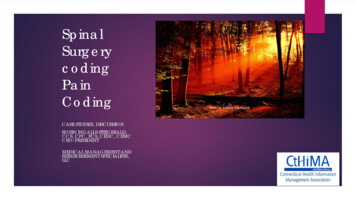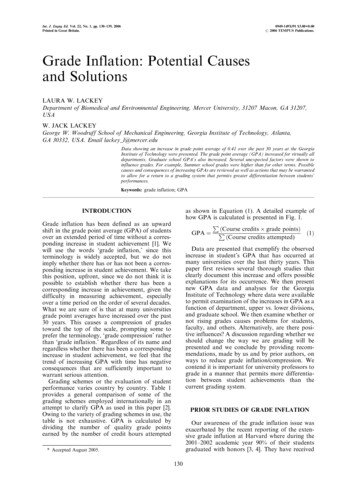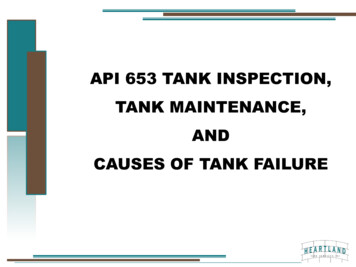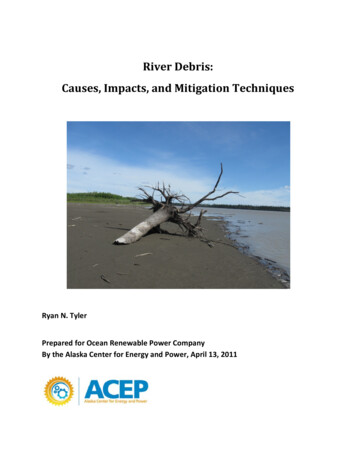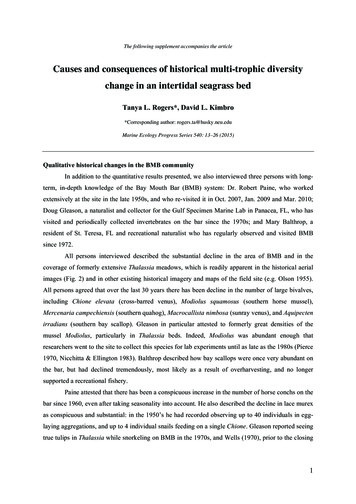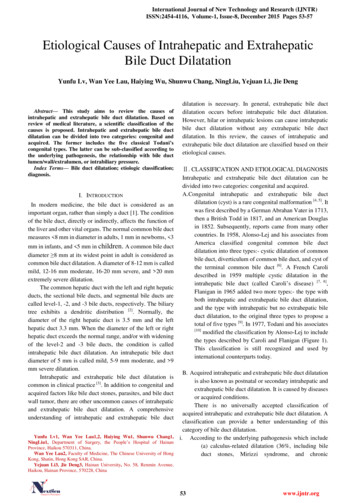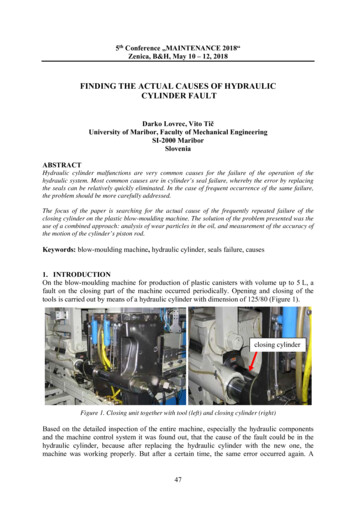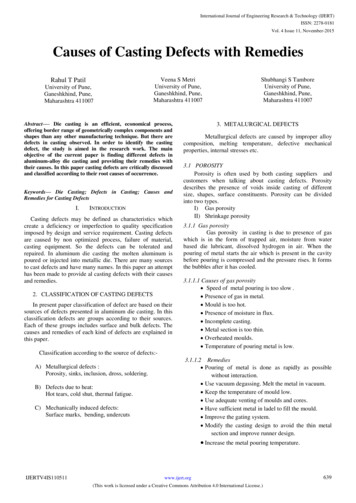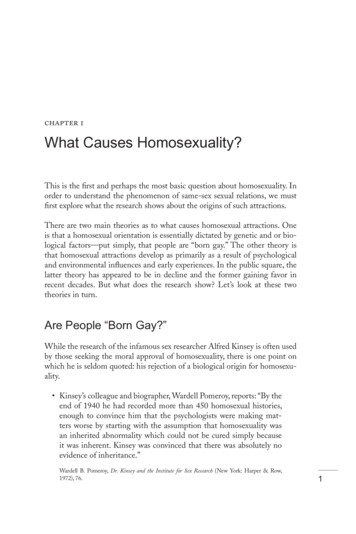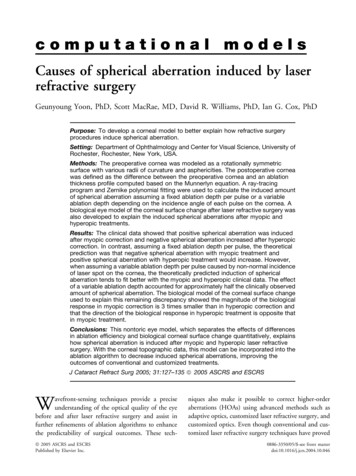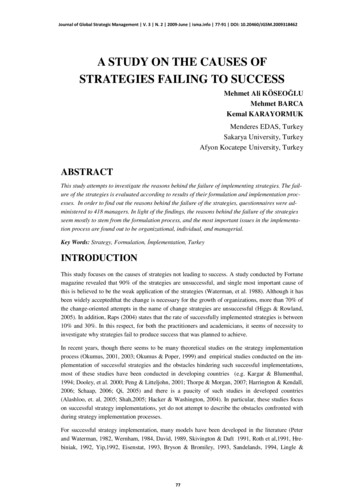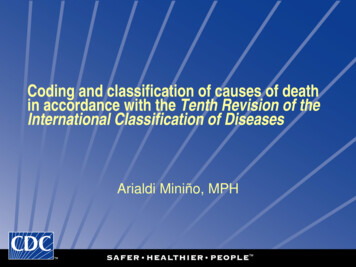
Transcription
Coding and classification of causes of deathin accordance with the Tenth Revision of theInternational Classification of DiseasesArialdi Miniño, MPH
The InternationalClassification of Diseases(ICD)
DefinitionThe ICD is a system of categories to which morbidentities of either external or pathological causationare assigned according to established criteria.The ICD is developed collaboratively between theWorld Health Organization (WHO) and variousinternational centers.
Dates for ICD Revisions Implementedin the United StatesFirst Revision: 1900-1909Second Revision: 1910-1920Third Revision: 1921-1929Fourth Revision: 1930-1938Fifth Revision: 1939-1948Sixth Revision: 1949-1957Seventh Revision: 1958-1967Eighth Revision: 1968-1978Ninth Revision: 1979-1998Tenth Revision: 1999 to present
Differences between the ICD and ICD-CMThe ICD is maintained and coordinated by WHO; ICDCM is maintained by the United States, butcoordinated with WHOThe ICD is updated every 10-20 years; ICD-CM isupdated annuallyThe ICD-CM has greater detail than the ICD
Standardizing functions of the ICDThe ICD defines:Death certificate formCodes, categories and chaptersRules for uniformly selecting the UCLists for presenting and tabulating mortality andmorbidity statisticsTerms such as “low birth weight,” “pre-term,”“neonatal period,” “maternal death.”
Structure of ICD-10Volume I: main classification, list of 3-charactercategories, tabular list for inclusions, and 4character subcategories; also morphology codes,tabulation lists, definitions and regulationsVolume II: coding rules and history of the ICDVolume III: alphabetical index
Structure of ICD-10ICD-10 is based on 3-digit categories ranging fromA00-Z99Each 3-digit category can be divided into 10 4-digitsubcategoriesICD-10 contains 21 chaptersThe first character of each ICD-10 code is a letter, andletters are associated with chapters.
Structure of ICD-10Chapters I to XVII relate to diseases and other conditionsChapter XVIII relates to symptoms, signs and abnormalfindingsChapter XIX relates to injuries and other consequences ofexternal causesChapter XX relates to external causes of morbidity andmortalityChapter XXI is exclusive to morbidity relating to reasonsfor seeking medical care
Important definitionsinvolving causes of deathCause of deathUnderlying cause: “The disease or injury whichinitiated the train of morbid events leading directly todeath, or the circumstances of the accident orviolence which produced the fatal injury" Multiple causes: causes of death including not onlythe underlying cause but also immediate cause ofdeath and all other intermediate and contributoryconditions entered by the certifying physician
Approximateinterval:Onset to deathCAUSE OF DEATH (See instructions and examples)32. PART I. Enter the chain of events - - diseases, injuries, or complications - - that directly caused the death. DO NOT enterterminal events such as cardiac arrest, respiratory arrest, or ventricular fibrillation without showing the etiology. DO NOTABBREVIATE. Enter only one cause on a line. Add additional lines if necessary.IMMEDIATE CAUSE (Finaldisease or condition resulting in death)Part I: Lines 1-4a.Due to (or as a consequence of):Causes of death areentered sequentiallystarting with immediatecause and ending withthe underlying cause.To Be Completed By:MEDICAL CERTIFIERb.Sequentially list conditions,if any, leading to the causelisted on line a. Enter theUNDERLYING CAUSE (diseaseor injury that initiated the eventsresulting in death) LASTDue to (or as a consequence of):c.Due to (or as a consequence of):d.PART II. Enter other significant conditions contributing to death but not resulting in the underlying causegiven in Part I.33. WAS AN AUTOPSY PERFORMED?YesNoPartII34.WERE AUTOPSY FINDINGS AVAILABLETO COMPLETE THE CAUSE OF DEATH?35. DID TOBACCO USECONTRIBUTE TO DEATH?YesNoProbablyUnknown38. DATE OF INJURY36. IF FEMALE:Not pregnant within past yearPregnant at time of deathNot pregnant but pregnant within 42 days of deathNot pregnant but pregnant 43 days to 1 year before deathUnknown if pregnant within the past year39. TIME OF INJURY(Mo/Day/Yr)(Spell Month)42. LOCATION OF INJURY: State:Street & Number:43. DESCRIBE HOW INJURY OCCURREDOther significantYesNocontributing29. MANNERconditionsOF cideHomicideCould not beDetermined40. PLACE OF INJURY (e.g., Decedent’s home, constructionsite, restaurant, wooded area)41. INJURY AT WORK?YesCity or Town:Apartment No.NoZip Code:Box 43. How44.injuryoccurredIF TRANSPORTATION INJURY, SPECIFYDriver/OperatorGenerally determinesexternal cause ofPassengerPedestriandeaths involving injuries.Other (Specify)
ICD-10 rules for selection ofunderlying cause of deathSelection RulesGeneral PrincipleRule 1Rule 2Rule 3Rules for Modification of Selected CauseRule A: Senility and other ill-defined conditionsRule B: Trivial conditionsRule C: LinkageRule D: SpecificityRule E: Early and late stages of diseaseRule F: Sequelae
NCHS' Automated Coding System for producingunderlying cause of deathSoftware for Capturing Software for Converting Software for Applying ICD's SelectionMedical TermsText of Medical Terms& Modification Ruleson Death Certificateinto ICD Codesto select Underlying CauseSuperMICARinputACMEoutput
The Concept of “Sequence”The term refers to two or more conditions enteredon successive lines of Part I, each condition beingan acceptable cause of the one entered on the lineabove it. If there is more than one cause of death ina line of the certificate, it is possible to have morethan one reported sequence.
General PrincipleWhen more than one condition is entered onthe certificate, select the condition enteredalone in the lowest-used line of Part I only if itcould have given rise to all the conditionsentered above it.
Two Ways to Apply the GeneralPrincipleImmediate cause reportedon Part I (a) of certificate is an acceptable cause of YESIntermediate cause reportedon Part I (b) of certificateYES is an acceptable cause of Intermediate cause reportedon Part I (c) of certificateYES is an acceptable cause of Tentative underlying causereported on Part I (d) of certificate
Two Ways to Apply the GeneralPrincipleIntermediate cause reportedon Part I (c) of certificateImmediate cause reportedon Part I (a) of certificateIntermediate cause reportedon Part I (b) of certificate is an acceptable cause of every conditionreported on lines above itTentative underlying causereported on Part I (d) of certificate
Example 1Cerebral hemorrhage1 monthNephritis6 monthsCirrhosis of liver2 years
Example 1Cerebral hemorrhage1 monthNephritis(I61.9)(N05.9)Cirrhosis of liver(K74.6)2 yearsReported underlying cause is K74.6(“Other and unspecified cirrhosis of liver”)6 months
Example 1Cerebral hemorrhage1 monthNephritis(I61.9)(N05.9)Cirrhosis of liver(K74.6)2 yearsTentative underlying cause is K74.6(“Other and unspecified cirrhosis of liver”)6 months
Example 2Cardiac arrest with terminal hypostatic pneumoniaHypertension
Example 2(I46.9) (J18.2)Cardiac arrest with terminal hypostatic pneumoniaHypertensionReported underlying cause is I10[“Essential (primary) hypertension”](I10)
Example 2(I46.9) (J18.2)Cardiac arrest with terminal hypostatic pneumoniaHypertensionTentative underlying cause is I10[“Essential (primary) hypertension”](I10)
Example 2(I46.9) (J18.2)Cardiac arrest with terminal hypostatic pneumoniaHypertensionTentative underlying cause is I10[“Essential (primary) hypertension”](I10)
General PrincipleThe General Principle does not apply: When more than one condition has beenentered on the lowest-used line of Part I If the single condition entered in the lowestused line of Part I could not have given rise toall the conditions entered above itWhat then ?
Selection RulesRule 1“If the General Principle does not apply and there is areported sequence terminating in the condition firstentered on the certificate, select the originating causeof this sequence. If there is more than one sequenceterminating in the condition mentioned first, select theoriginating cause of the first-mentioned sequence.”
Example 3(I61.9) (J18.2)Cerebral hemorrhage and hypostatic pneumoniaχProstate hypertrophy and Diabetes(N40) (E14.9)Tentative underlying cause is E14.9 via Rule 1;General Principle not applicable;more than one condition entered in last-used line of Part I
Selection RulesRule 2“If there is no reported sequence terminating in thecondition first entered on the certificate, select thisfirst-mentioned condition.”
Example 4Pernicious anemia and comaAtherosclerosis
Example 4χ AtherosclerosisPernicious anemia and coma(D51.0) (R40.2)(I70.9)General Principle not applicable;single condition entered in the lowest-used line of Part Icould not have given rise to all the conditions entered above i
Example 4χ AtherosclerosisPernicious anemia and coma(D51.0) (R40.2)(I70.9)Rule 1 not applicable; no valid sequence terminatingin the condition first entered on the certificate.
Example 4Pernicious anemia and coma(D51.0) (R40.2)Atherosclerosis(I70.9)Tentative underlying cause is D51.0via Rule 2: select the first-mentionedcondition.
Selection RulesRule 3 (“direct sequel”)“If the condition selected by the General Principleor by Rule 1 or Rule 2 is obviously a directconsequence of another reported condition,whether in Part I or Part II, select this primarycondition.”
Example 5Cardiac arrestGastric hemorrhageGastric ulcer(I46.9)(K92.2)(K25.9)Through “direct sequel” Rule 3 a third code K259 isselected instead of K922 as tentative underlying causebecause the gastric hemorrhage is a direct sequel ofK25.9 as per Table E (Part 2c).
Modification RulesRule A (“senility and other ill-definedconditions”)“Where the selected cause is ill-defined and acondition classified elsewhere is reported on thecertificate, re-select the cause of death as if the illdefined condition had not been reported, except totake account of that condition if it modifies thecoding.”
The following are regarded as ill-defined: I46.9 (Cardiac arrest, unspec.);I95.9 (Hypotension, unspec.);I99 (Other and unspec. disorders of circulatory system);J96.0 (Acute respiratory failure);J96.9 (Respiratory failure, unspec.);P28.5 (Respiratory failure of newborn);R00-R94, R96-R99* (Chapter of Ill-defined & unknowncauses of mortality)* Note that R95, Sudden infant death syndrome,is not considered an “ill-defined” condition.
Example 5Senility and hypostatic pneumonia (R54) (J18.2)Rheumatoid arthritis(M06.9)Senility is considered ill-defined. Reselect TUC as if R54had not been reported.M06.9 is selected as TUC via General Principle.No modifications (IDDC, SENMC, SENDC) warranted.
Modification RulesRule B (“trivial conditions”)*“Where the selected cause is a trivial condition unlikely tocause death, and a more serious condition (any conditionexcept an ill-defined or another trivial condition) isreported, reselect the underlying cause as if the trivialcondition had not been reported. If the death was theresult of an adverse reaction to treatment of the trivialcondition, select the adverse reaction.When a trivial condition is reported as causing any othercondition, the trivial condition is not discarded and Rule Bis not applicable.”*For a list of trivial conditions, see instructionmanual Part 2c, table H.
Modification RulesRule C (“linkage”)“Where the selected cause is linked by a provision in theClassification or in the notes for use in underlying cause codingwith one or more of the other conditions on the certificate, codethe combination.Where the linkage provision is only for the combination of onecondition specified as due to another, code the combination onlywhen the correct causal relationship is stated or can be inferredfrom application of the selection rules.Where a conflict in linkages occurs, link with the condition thatwould have been selected if the cause initially selected had notbeen reported. Make any further linkage that is applicable.”
Example 6Pneumonia and emphysema(J18.9) (J43.9)Bronchitis(J40)Cerebral arteriosclerosis(I67.2)J40 is selected as TUC via General Principle.However
Example 6Pneumonia and emphysema(J18.9) (J43.9)Bronchitis(J40)Cerebral arteriosclerosis(I67.2)Addressing J40 in Table E of Part 2c indicates a need to selecta combined code (J44.8) as TUC because of the simultaneouspresence of J40 and J43.9.J44.8 is “Other specified chronic obstructive pulmonary disease
Modification RulesRule D (“specificity”)“Where the selected cause describes a condition ingeneral terms and a term that provides more preciseinformation about the site or nature of this condition isreported on the certificate, prefer the more informativeterm. This rule will often apply when the general termbecomes an adjective, qualifying the more preciseterm.”
Modification RulesRule E (“early and late stages of disease”)“Where the selected cause is an early stage of a diseaseand a more advanced stage of the same disease isreported on the certificate, code to the more advancedstage.This rule does not apply to a ‘chronic’ form reported asdue to an ‘acute’ form unless the classification givesspecial instructions to that effect.”
Modification RulesRule F (“sequela”)“Where the selected cause is an early form of a conditionfor which the Classification provides a separate ‘Sequelaof .’ category, and there is evidence that death occurredfrom residual effects of this condition rather than fromthose of its active phase, code to the appropriate ‘Sequelaof .’ category.”
“Sequela of ” categoriesB90.- Sequela of tuberculosisB91 Sequela of poliomyelitisB92 Sequela of leprosyB94.- Sequela of other and unspecified infectious and parasitic diseasesE64.- Sequela of malnutrition and other nutritional deficienciesE68 Sequela of hyperalimentationG09 Sequela of inflammatory diseases of central nervous systemI69.- Sequela of cerebrovascular diseaseO97 Death from sequela of direct obstetric causesY85 - Y89 Sequela of external causes
Example 7Fractured spine(T08) ?Passenger in auto accident, 18 mos. ago (V49) ?These are likely ICD codes for these conditions.However
Example 7Fractured spine(T91.1)Passenger in auto accident, 18 mos. ago (Y85.0)Presence of mention of injury having occurredlong time ago gives rise to sequela codes.As usual, TUC goes to the external cause of the injury(Y85.0)– not the injury code itself
Integration of supplementalitems in coding process
Other items that may be usedInjury details Manner of death Pregnancy status Tobacco use
Example 8Subdural hematomaCVA(S06.5)(I64)XFell while walking (W18)Tentative underlying cause is S06.5 “Traumatic subduralhemorrhage” by Rule 2. The only information on anaccidental cause of a hematoma is in the injurydescription. W18 “Other fall on same level” is assignedand selected as the underlying cause.
Pregnancy statusIdeal processing situation: Cause-of-death statement would includeinformation about role of pregnancy and timingbetween pregnancy and death, so separatequestion would not be used in coding Separate pregnancy questionwould allow calculation ofdeaths of pregnant or recentlypregnant women and assistsurveillance programs
Pregnancy statusProcessing reality: Pregnancy question is frequently used in tandemwith cause-of-death statement Same general guidelines used for separatequestions as before: Information in question takeninto consideration when coding
Example 9Female, 28 years oldCVA(O96)Hypertension(O96)PregnancyXTentative underlying cause is O96 (“Death from any obstetric cause occurring morethan 42 days but less than one year after delivery”) by general principle. No furthermodification is applicable.
Example 10Female, 24 years oldCVA(O99.4)Hypertension(O16)PregnancyXTentative underlying cause is O16 (“Unspecified maternal hypertension”) by generalprinciple. No further modification is applicable.
Tabulation Lists
Background One of the purposes of the ICD is to providestandard lists for presenting mortality dataWHO recommends four special tabulation lists forunderlying cause of death dataThe United States has created its own tabulationlists; however, the NCHS lists can be used torecreate the WHO tabulation lists
Instruction manual part 9 Instruction Manual Part 9, ICD-10 Cause-of-DeathLists for Tabulating Mortality StatisticsNCHS started to use this manual in 1999Describes 12 tabulation lists (updated for 2011)http://www.cdc.gov/nchs/nvss/instruction manuals.htm
Multiple Causes of Death
A Word on Multiple Causes of DeathValuable supplement to underlying cause dataBy using only the underlying cause of death,valuable information is lostIn the United States, about 75% of deathcertificates have more than one condition listed,with the average about 3 conditionsAn underused resource
Multiple Causes of Death,cont.The U.S. developed an automated system thatcaptures this additional information and producesanalyzable output based on itBegan with 1968 dataACME: Automated Classification of Medical Entities(underlying cause output)TRANSAX: Translation of Axes (multiple causeoutput)
Multiple Causes of Death,cont.Two types of related multiple-cause outputs:Entity axis Record axis
Multiple Causes ofDeathEntity AxisCloser to what is actually entered by certifier Includes the placement of the condition on the deathcertificate Anatomy of an entity axis code21K359Indicates whether Part 1 or Part 2and which line in Part 1ICD-10 code itselfIndicates sequence orderwithin line
Multiple Causes ofDeathRecord AxisA transformation of the entity axis More useful for analysis and tabulation Redundant conditions are deleted Certain conditions are combined
Multiple Causes ofDeathAnalytic uses include: The only source of “nature of injury” informationAccording to WHO conventions, we tabulate the deathaccording to the external cause rather than thenature of the injury
Number of drug poisoning deaths involving opioid analgesicsby opioid analgesic category: United States, 1999--200912,000Natural and semisynthetic opioidanalgesicNumber of deaths10,0008,000Methadone6,0004,000Synthetic opioidanalgesic,excludingmethadone2,00001999 2000 2001 2002 2003 2004 2005 2006 2007 2008 2009NOTES: Opioid analgesic categories are not mutually exclusive. Deaths involving more than one opioid analgesic category shown in this figure are countedmultiple times. Natural and semi-synthetic opioid analgesics include morphine, oxycodone and hydrocodone; and synthetic opioid analgesics includefentanyl.SOURCE: CDC/NCHS, National Vital Statistics System; and Warner M, Chen LH, Makuc DM, Anderson RN, Miniño AM. Drug poisoning deaths in the UnitedStates, 1980–2008. NCHS data brief, no 81. Hyattsville, MD: National Center for Health Statistics. 2011. http://www.cdc.gov/nchs/data/databriefs/db81.htm
Multiple Causes ofDeathAnalytic uses include: Associations among conditions contributing to death
Multiple Causes ofDeathAnalytic uses include: Studies of the nature and quality of medicalcertification To see how often the medical certifier correctlycompletes the death certificate
Thank youRobert N. Anderson, Ph. D.RNAnderson@cdc.govArialdi M. Miniño, MPHAMinino@cdc.gov
The first character of each ICD-10 code is a letter, and letters are associated with chapters. Structure of ICD-10 Chapters I to XVII relate to diseases and other conditions . Chapter XVIII relates to symptoms, signs and abnormal findings .File Size: 1MB
